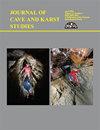Rock Pigeon Cave, Colorado: development and mineralogy
IF 0.5
4区 地球科学
Q4 GEOSCIENCES, MULTIDISCIPLINARY
引用次数: 0
Abstract
The late Cretaceous Mancos Shale in western Colorado contains several vadose caves developed entirely within the shale. The largest of these, Rock Pigeon Cave, is over 300 m in length and contains a seasonal stream. The cave, and others like it, is hypothesized to develop as a result of the oxidation of disseminated pyrite in the shale by descending meteoric water with resulting sulfate ions reacting with the carbonate component of the shale to produce gypsum. The gypsum pries apart the shale, increasing its secondary porosity, and allows flowing water to remove shale particles via corrasion. As these particles are removed, they are transported down-gradient to an outlet, allowing continuous openings (cave passages) to develop. Extensive sulfate mineralization is observed within the cave and takes several forms: soft globular deposits on rocks at water level, a white to tan crust on shale surfaces, dry crusts on the passage floor following evaporation of pools, and needle and hair-like extrusions on passage walls. Powder X-ray diffraction (XRD) indicates that these deposits are a mixture of thenardite and blodite with lesser amounts of gypsum, hexahydrite, and konyaite. Na+, Mg2+, and SO4 2- ions in the entering stream are the source of the sulfate minerals at stream level and on the wetted slopes above. These come out of solution as the cave stream and pools evaporate with sulfates precipitating as saturation is reached. Fibrous, needle-like sulfates on walls above the wetted zone are a result of crystallization by evaporation: fluids containing sulfate ions are extruded and evaporate at the rock/air interface. Other minerals, e.g., deposits containing goethite and jarosite, are seen on passage walls as reaction products from oxidation of pyrite in the shale.科罗拉多州的岩鸽洞穴:开发与矿物学
科罗拉多州西部白垩纪晚期的曼科斯页岩中有几个完全发育在页岩中的岩溶洞。其中最大的岩鸽洞长度超过 300 米,内有一条季节性溪流。据推测,该洞穴以及其他类似洞穴的形成,是由于流星水冲刷页岩中的黄铁矿,硫酸根离子与页岩中的碳酸盐成分发生反应,生成石膏。石膏将页岩撬开,增加了页岩的二次孔隙率,使流水可以通过腐蚀作用带走页岩颗粒。当这些颗粒被带走时,它们就会被向下输送到出口处,从而形成连续的开口(洞穴通道)。在洞穴内可以观察到广泛的硫酸盐矿化现象,有多种形式:水位处岩石上的软球状沉积物、页岩表面的白色至棕褐色结壳、水池蒸发后通道地面上的干燥结壳以及通道壁上的针状和毛发状挤压物。粉末 X 射线衍射(XRD)表明,这些沉积物是霞石和白云石的混合物,还有少量石膏、六水石和孔雀石。溪流中的 Na+、Mg2+ 和 SO4 2- 离子是溪流水平面和上方湿润斜坡上硫酸盐矿物的来源。随着洞穴溪流和水池的蒸发,这些矿物质从溶液中析出,当达到饱和状态时,硫酸盐沉淀。湿润区上方岩壁上的纤维状、针状硫酸盐是蒸发结晶的结果:含有硫酸根离子的流体被挤出并在岩石/空气界面蒸发。通道壁上的其他矿物,例如含有鹅卵石和箭石的沉积物,是页岩中黄铁矿氧化的反应产物。
本文章由计算机程序翻译,如有差异,请以英文原文为准。
求助全文
约1分钟内获得全文
求助全文
来源期刊

Journal of Cave and Karst Studies
地学-地球科学综合
CiteScore
1.90
自引率
0.00%
发文量
6
审稿时长
>12 weeks
期刊介绍:
The Journal of Cave and Karst Studies is a multidisciplinary journal devoted to cave and karst research. The Journal is seeking original, unpublished manuscripts concerning the scientific study of caves or other karst features. Authors do not need to be members of the National Speleological Society, but preference is given to manuscripts of importance to North American speleology.
 求助内容:
求助内容: 应助结果提醒方式:
应助结果提醒方式:


